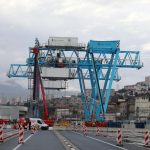After many years of preparations and negotiations, the destiny of Croatia’s LNG terminal project on the island of Krk is still unknown.
Everybody has an opinion about whether, where and how Croatia should or should not construct its long-awaited LNG terminal. The project has been discussed for years, and the start of construction is always just six to nine months away. But, so far, not a single shovel of dirt has been moved, although the project is supposedly of strategic importance not just for Croatia, but for the whole of European Union, which wants to make itself more energy independent with regards to Russian gas supplies.
The issue is not just economic, but also geopolitical. The government is under pressure from the United States to start with the construction as soon as possible, with the European Union deciding to finance about a third of the cost, while the Russian ambassador in Croatia keeps repeating that there is no need for the expensive terminal to be constructed, given that Croatia has long-term contracts for import of less costly and, at least for now, more readily available Russian gas which comes through pipelines.
While the fate of the terminal is not yet know, what is know is that the United States is actively advocating for the project, with a seemingly endless procession of US government officials coming to Zagreb and, together with new Ambassador Robert Kohorst, meeting with Croatian dignitaries, explaining the need for Europe to have more ways of transporting gas. Americans have promised expert support for the project, but not the funds for the construction, at least as far as publicly is known.
The implementation of the project is made even more difficult due to the opposition of the local authorities, who would rather see a land-based terminal built, as were initial plans, and not a floating one, which is currently a more likely option given that it is less expensive and can be built more quickly.
The latest addition to the discussion has been made by Croatia’s Member of European Parliament Ivan Jakovčić, from the regional Istrian party (IDS), who joined the local authorities in their demands that a permanent land-based terminal should be built. If the government still opts for the floating one, then Jakovčić wants it to be moved from Krk to the open seas. “It is well-known that the 2016 study financed by the European Commission has shown that the land-based terminal is better in technical, environmental and financial terms. Also, the local authorities are strongly against the floating terminal idea, and we have to respect their opinion,” said Jakovčić recently. “It is time for the Croatian authorities to finally start spending public funds the way people want it. We all know that the EU does not like to finance projects which are opposed by local authorities and NGOs.”
Jakovčić’s idea is supported by some members of the County Assembly. “This year, the construction of four floating terminals will start in the Gulf of Mexico. They will be located 50 miles from the coast. Why are we building a terminal on the shore at Omišalj on Krk?” asked assemblyman Hrvoje Burić. A major protest against the terminal is planned for 3 March in the centre of nearby Rijeka, which is the principal town on the northern Adriatic coast and the county capital.
Other possible locations being mentioned are the Bay of Bakar and the Bay of Plomin, both on the mainland. The somewhat hypocritical explanation is that these two locations have been polluted by other industrial facilities already located there, so one more polluter would not make much difference. However, possible relocation of the terminal would delay the project even further since new spatial documentation and plans should first be prepared.
The opponents of the project say that the floating terminal will be harmful to the environment due to chemicals used in the process. That could endanger the nature and tourism, which is the most important industry on the island of Krk and the rest of Croatia. Still, the government seems more intent than ever to push the project through and has announced plans to adopt a special law this spring which would make it easier to implement the project.
Another issue is the terminal’s capacity, which is currently ultimately projected at seven billion cubic metres of gas a year. Given that Croatian needs are about 2.5 billion, the question is who will use the rest. No contracts with potential sellers or buyers of gas have been signed so far, and without such agreements it is impossible to ensure the long-term viability of the project.
Despite everything, Goran Frančić, the CEO of LNG Croatia, a company which is supposed to lead the project, says that all activities concerning the floating LNG terminal are going according to the planned schedule, in line with the deadlines which the EU imposed in its decision to co-finance the construction. The binding offers for capacity lease should be sent by the end of April, while the final investment decision is supposed to be made before summer.
“About 20 companies have expressed their initial interest for the lease of capacities of the future floating terminal, with 12 of them submitting offers for the lease of capacity which is greater than 2.6 billion cubic metres of gas a year, which will initially be available given the current capacity of the gas pipeline network in the area,” said Frančić in a recent interview.
The company is also negotiating about the acquisition of the so-called FSRU facility, which is the critical element of the terminal. This contract is expected to be signed during the second quarter of this year. As for the environmental issues, Frančić said that the decision on the environmental acceptability of the project should be made by the end of March. For the financing of the project, in addition to EU funds, the company and the government are looking for possible strategic partners and loans.
For the goal of the terminal becoming operational in 2020, it is necessary for the final decision to be made by the end of June. While all signs point to start of the construction in the second half of the year, the experience which Croatia has with other “strategically-important projects,” which are inevitably delayed by many years or forever, tells us that surprises are not just possible, but likely.







